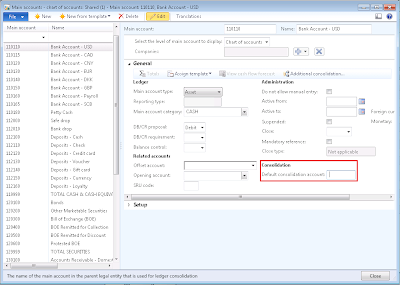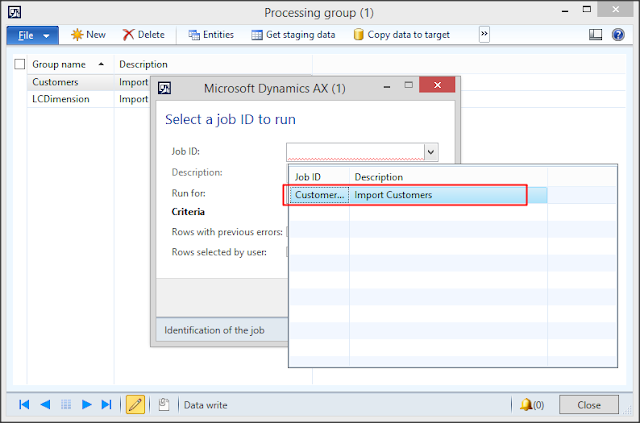Perform Consolidation in AX 2012
Consolidation functionality in AX 2012 can be used to combine the financial results for several subsidiaries into a single, consolidated company.
1. Setup General Ledger Parameters
2. Setup chart of account.
3. Setup default currency and exchange rates
4. Specify system account for consolidation exchange differences
5. Setup Elimination Rules
Note: The consolidation company will only be used to gather transactions of several subsidiaries and can not be used for daily transactions.
To prepare a consolidation Company (Parent) perform the following steps:
1. In the Organization Administration module click Setup à organization à Legal Entities
2. Click the NEW button to create a new legal entity.
3. In the general FastTab Click the use for financial consolidation process check box.
4. Mark the use for financial elimination process check box to allow elimination transaction to be created in the ledger of the legal entity.
5. Open up the newly created consolidation company and go to General Ledger à Setupà Ledger
6. Select the default information such as Chart of Accounts / Accounting Currency / Exchange rates / Fiscal Calendars etc.
Currency and Exchange Rates
If some subsidiaries have foreign currencies as their company currencies, click General ledger, click Setup, click Currency, and then click Currencies.
· Create the foreign currencies.
· To Set up exchange rates click General Ledger > setup > Currency > currency exchange rates .
Setup Consolidation System Account
You must setup a consolidation system account to automatically post differences resulting from using different exchange rate types for different accounts when consolidating subsidiaries into the consolidation company.
Go to General Ledger à Setup à posting à Accounts for automatic transactions
In the Posting type field use the arrow to select one of the following:
Balance account for consolidation differences if you are consolidating an integrated foreign subsidiary.
Profit & loss account for consolidation differences if you are consolidating a self-sustaining subsidiary or a company that contains the results of several self-sustaining subsidiaries and are using translation methods to consolidate the data.
Ledger Elimination Rule
In the start we have marked “use for financial elimination process” check box in the consolidation company because the consolidation company should only contain transactions that occur between parent company and the company outside the group and all the intercompany transaction should be eliminated.
Let’s setup ledger elimination rule in the consolidation company
Go to General Ledger à Setup à Posting à Ledger Elimination Rules
- Click on new button to create a new rule.
- In the general FastTab specify the Consolidation company in the destination company field
- Mark the active check box
- In the journal settings field group specify the Elimination Journal
- Now click on lines button
In the elimination method field there two options
Net Change: eliminates an accounts net change for the specified period(most common method)
Fixed amount: eliminates specified amount for an account.
In the source account field select intercompany accounts such as sales /Expense / purchases / receivable payables
Select “Source” in the account specification and dimension specification fields.
Setup in Subsidiary Company
Map Chart of Accounts
The best case would be that the Consolidating company has the same chart of accounts as subsidiary accounts. If that is the case no need to perform the accounts mapping.
If the chart of account of subsidiary is not similar with the parent company perform the following steps to map accounts
In the subsidiary company go to General ledger > Common > Main Accounts > select ledger account in the general FastTab enter the corresponding account number of the Consolidated company in default consolidation account field

Map Financial Dimension
Follow these steps to map a dimension in the subsidiary to the consolidated company.
- Click General Ledger à Financial Dimension à Financial Dimensions.
- Select a Dimension and click financial dimension values button
- In the group dimension field on the general FastTab, enter the dimension which will be used for consolidation.
Perform Online Consolidation
Microsoft Dynamics AX supports consolidation
- Online Consolidation – Subsidiary company resided within the same database
- Import / Export – If subsidiary company resides in a different database than an export / import option may be used to get the data in the specified template (delimited file)
Click on General ledger à Periodic à Consolidate à Consolidate online
Criteria Tab
Financial dimension Tab
In the specification field you can specify how the dimension should consolidate from the subsidiary and specify the segment order
Legal Entities Tab
Elimination Tab
In the currency translation tab set the translation exchange rate type if subsidiary company has different accounting currency. And click OK.
You can view the consolidation transaction by clicking General Ledger à Inquiry àConsolidation
Click transaction button then click on actual.






















































